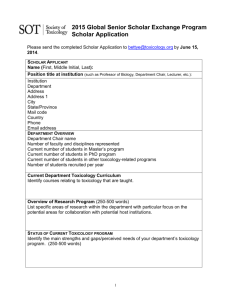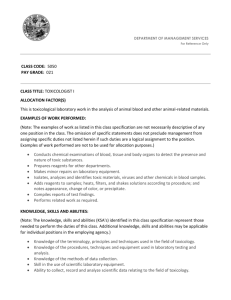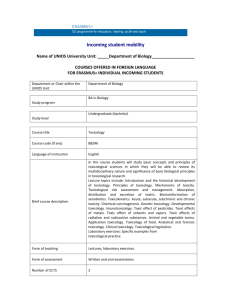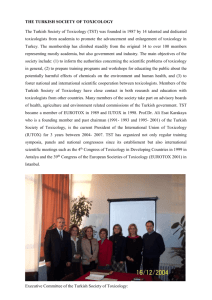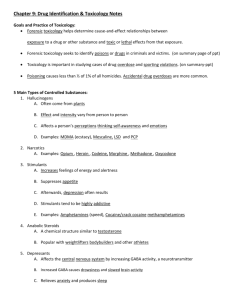Meeting Flyer - Society of Toxicology
advertisement
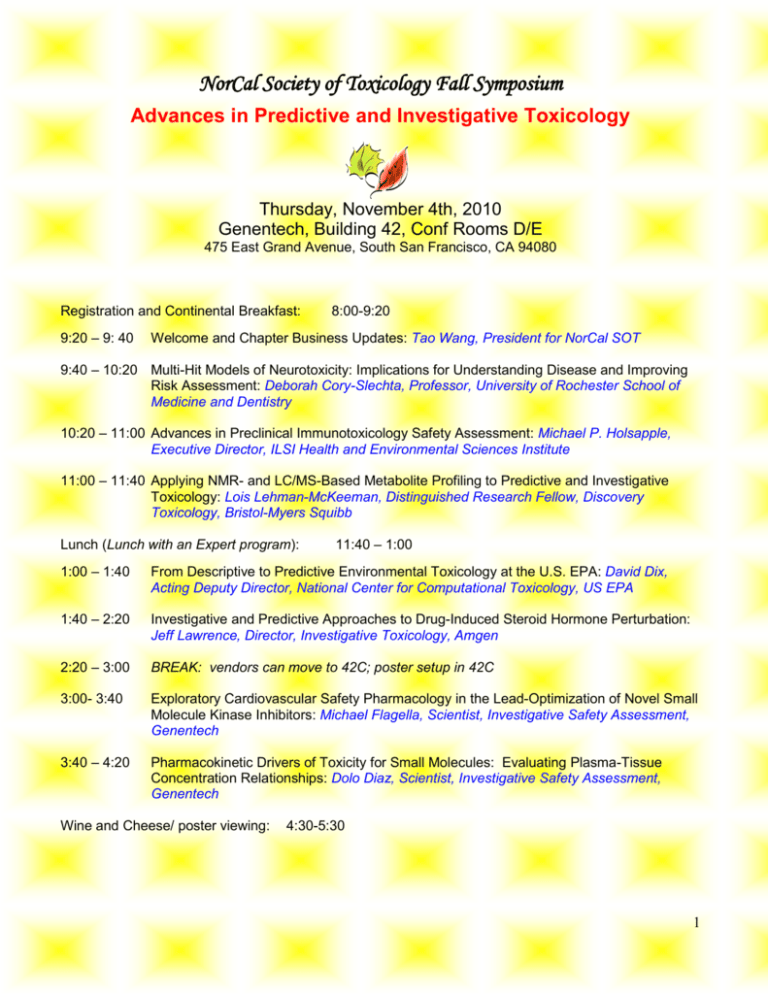
NorCal Society of Toxicology Fall Symposium Advances in Predictive and Investigative Toxicology Thursday, November 4th, 2010 Genentech, Building 42, Conf Rooms D/E 475 East Grand Avenue, South San Francisco, CA 94080 Registration and Continental Breakfast: 9:20 – 9: 40 8:00-9:20 Welcome and Chapter Business Updates: Tao Wang, President for NorCal SOT 9:40 – 10:20 Multi-Hit Models of Neurotoxicity: Implications for Understanding Disease and Improving Risk Assessment: Deborah Cory-Slechta, Professor, University of Rochester School of Medicine and Dentistry 10:20 – 11:00 Advances in Preclinical Immunotoxicology Safety Assessment: Michael P. Holsapple, Executive Director, ILSI Health and Environmental Sciences Institute 11:00 – 11:40 Applying NMR- and LC/MS-Based Metabolite Profiling to Predictive and Investigative Toxicology: Lois Lehman-McKeeman, Distinguished Research Fellow, Discovery Toxicology, Bristol-Myers Squibb Lunch (Lunch with an Expert program): 11:40 – 1:00 1:00 – 1:40 From Descriptive to Predictive Environmental Toxicology at the U.S. EPA: David Dix, Acting Deputy Director, National Center for Computational Toxicology, US EPA 1:40 – 2:20 Investigative and Predictive Approaches to Drug-Induced Steroid Hormone Perturbation: Jeff Lawrence, Director, Investigative Toxicology, Amgen 2:20 – 3:00 BREAK: vendors can move to 42C; poster setup in 42C 3:00- 3:40 Exploratory Cardiovascular Safety Pharmacology in the Lead-Optimization of Novel Small Molecule Kinase Inhibitors: Michael Flagella, Scientist, Investigative Safety Assessment, Genentech 3:40 – 4:20 Pharmacokinetic Drivers of Toxicity for Small Molecules: Evaluating Plasma-Tissue Concentration Relationships: Dolo Diaz, Scientist, Investigative Safety Assessment, Genentech Wine and Cheese/ poster viewing: 4:30-5:30 1 Registration Pre-registration will facilitate planning for security and parking purposes. Registration is $25 for NorCal SOT members, $35 for nonmembers and FREE for students/post-docs. Additional $5 will be applied to onsite registration. Students are encouraged to bring posters documenting their research and will receive $50 for doing so. Students may have their posters printed by contacting Steve Dizio at sdizio@dtsc.ca.gov. Sponsors This meeting is generously sponsored by the following: BioReliance Charles River Genentech Covance MPI SRI ChanTest Corp Toxicon Pacific BioLabs Huntingdon Life Sciences ITR Lab Zenas Technology BMG Lab Tech Battelle Abstracts and Biographical sketches Deborah Cory-Slechta, Professor, University of Rochester School of Medicine and Dentistry Multi-Hit Models of Neurotoxicity: Implications for Understanding Disease and Improving Risk Assessment It is increasingly recognized that most human diseases and disorders are multi-factorial in etiology. Yet both experimental models and epidemiological studies evaluating the potential contributions of environmental or occupational chemical exposures to these diseases generally focus on the impact of a single chemical exposure in isolation from other risk factors. This includes interactions with other chemical exposures, as is more consistent with the human environment. This talk will present the results from studies of multi-hit models of pesticide exposures in conjunction with other risk factors for the Parkinson’s disease phenotype, and for cognitive deficits in children in response to elevated lead exposure combined with prenatal stress, cooccurring risk factors for low socioeconomic status communities. Based on such approaches, it will suggest strategies for improving animal models and epidemiological studies of neurotoxicity to advance our understanding of diseases and disorders, and to move forward cumulative risk assessment by using common adverse outcomes to define those chemical exposures and other risk factors that should be evaluated in combination. Bio: Dr. Deborah Cory-Slechta became a faculty member at the University of Rochester Medical School (URMC) in 1982 where she rose from Assistant Professor to Professor. She became Chair of its Department of Environmental Medicine and Director of the NIEHS Environmental Health Sciences Center in 1998, and served as Dean for Research from 2000-2002.From 2003-2007, she served as Director of the Environmental and Occupational Health Sciences Institute (EOHSI) and Chair of the Department of Environmental and Community Medicine at the UMDNJ-Robert Wood Johnson Medical School in New Jersey, before returning to URMC as Professor in Environmental Medicine and Pediatrics. Dr. Cory-Slechta has served on national review and advisory panels of the National Institutes of Health, the National Institute of Environmental Health 2 Sciences, the Food and Show Desktop.scf Drug Administration, the National Center for Toxicological Research, the Environmental Protection Agency, the National Academy of Sciences, the Institute of Medicine, and the Agency for Toxic Substances and Disease Registry, Centers for Disease Control. She currently serves on the Science Advisory Board of the US EPA and on the Advisory Committee for Childhood Lead Poisoning Prevention of the CDC. In addition, Dr. Cory-Slechta has served on the editorial boards of the journals Neurotoxicology, Toxicology, Toxicological Sciences, Fundamental and Applied Toxicology, Neurotoxicology and Teratology, and American Journal of Mental Retardation. She has held the elected positions of President of the Neurotoxicology Specialty Section of the Society of Toxicology, President of the Behavioral Toxicology Society, and been named a Fellow of the American Psychological Association. Her research has focused largely on the relationships between brain neurotransmitter systems and behavior, and how such relationships are altered by exposures to neurotoxicants, particularly the role played by environmental neurotoxicant exposures in developmental disabilities and neurodegenerative diseases. These research efforts have resulted in over 120 papers and book chapters to date. Michael P. Holsapple, Executive Director, ILSI Health and Environmental Sciences Institute Advances in Preclinical Immunotoxicology Safety Assessment This presentation will capitalize on the nearly 30 years of experience by the speaker as an immunotoxicologist. The advances in preclinical immunotoxicology safety assessment will be addressed from two important perspectives. The first perspective will be to consider the current state-of-the-science of immunotoxicity testing, as it relates to regulatory guidelines for immunotoxicology for both drugs and chemicals. The second perspective will be to highlight some of the contributions and current activities by the Immunotoxicology Technical Committee (ITC), one of the oldest and most productive components of the scientific portfolio within the ILSI Health and Environmental Sciences Institute (HESI). Bio: Dr. Holsapple is a toxicologist with over 30 years of experience. He received his graduate training in Pharmacology and Toxicology from Purdue University, having earned an M.S. in 1978 and a Ph.D. in 1981. From 1983–1994, he served on the faculty at the Medical College of Virginia/Virginia Commonwealth University in Richmond, VA. During his academic career, he served as the advisor for 8 Ph.D. and M.S. candidates, and as a member of the doctoral dissertation committees for 21 other students. From 1994-2002, Dr. Holsapple worked in the Toxicology, Environmental Research and Consulting Laboratories at the Dow Chemical Company in Midland, MI. During his industry career, his responsibilities included leading both the Immunotoxicology and the Respiratory Toxicology groups. Dr. Holsapple is currently the Executive Director of the Health and Environmental Sciences Institute (HESI), the global branch of the International Life Sciences Institute (ILSI). During his time with HESI, Dr. Holsapple has facilitated the organization’s emergence as a recognized global leader in advancing the state-of-the-science of safety and risk assessment. Dr. Holsapple has published over one hundred and fifty manuscripts and chapters. In recognition of his contributions to toxicology, Dr. Holsapple received the Society of Toxicology (SOT) Achievement Award in 1992. In recognition for his contributions to immunotoxicology, he received the Vos Award – Career Achievement in Immunotoxicology in 2009. Dr. Holsapple served on Council for the SOT from 2005-2007, and on Council for the American College of Toxicology (ACT) from 2003-2006. He was elected a ‘fellow’ in the Academy of Toxicological Sciences (A.T.S.) in 2006. Dr. Holsapple was elected into the Presidential track of the SOT in 2008, and is currently the President. Lois Lehman-McKeeman, Ph.D.Distinguished Research Fellow, Discovery Toxicology, Bristol-Myers Squibb Co., Princeton, NJ Applying NMR- and LC/MS-Based Metabolite Profiling to Predictive and Investigative Toxicology 3 Metabolomic profiles can provide important leads for identifying key events underlying toxicologic responses. Furthermore, as a likely phenotypic consequence of altered gene expression, metabolomic changes are important complementary data for determining the systemic relevance or significance of induction or repression of specific gene pathways. In this presentation, examples of how NMR- and LC/MS-based metabolite profiling have aided the identification of potential biomarkers and/or mechanisms of toxicity will be discussed. In particular, urinary profiles facilitated the discovery of methylhistidine metabolites as potential new biomarkers for assessing skeletal muscle toxicity. Evaluation of urine, serum and tissue lipid profiles have also afforded new perspectives on biochemical changes predictive of and mechanistically relevant for evaluating drug-induced phospholipidosis. There is potential for metabolomic investigations to identify non-invasive tools that translate from preclinical to clinical assessments and thereby facilitate human safety evaluation. Bio: Dr. Lois Lehman-McKeeman is currently a Distinguished Research Fellow in Discovery Toxicology at the Bristol-Myers Squibb Company in Princeton, NJ. She received a BS degree in Toxicology from the University of the Sciences in Philadelphia and holds a Ph.D. in Toxicology from the University of Kansas Medical Center. She was employed in the Human and Environmental Safety Division of the Procter and Gamble Company for 15 years prior to joining Bristol Myers Squibb in 2001. Lois has active research interests and programs broadly in biochemical mechanisms of toxicity and non-genotoxic mechanisms of carcinogenesis. She is also working to develop and apply metabonomic and transcriptomic technologies to mechanistic toxicology. She has published extensively in these fields. She has been active professionally in the Society of Toxicology (SOT) serving on numerous SOT committees, and she held elective office in the SOT as Councilor (2000-2002) and the SOT Awards Committee (2008-2010). In 2003 she was appointed Editor of Toxicological Sciences, a position she currently holds, and she serves on a number of other editorial boards. She was a member of the Human Subjects Review Advisory Board of the USEPA (2006-2010) and she has or is presently sitting on a variety of national and international advisory committees for EPA, NIH and IARC. She is a Trustee on the Board of Directors of the International Life Sciences Human and Environmental Safety Institute (ILSI-HESI). She was elected as a Fellow of the American Association for the Advancement of Science in 2008 and has been a fellow in the Academy of Toxicological Sciences since 2000. She was the recipient of the Robert Scala Award in Toxicology for research excellence in an industrial laboratory (1994), the Society of Toxicology Achievement Award (2003) and the George H. Scott Award for scientific excellence from the Toxicology Forum (2006). David Dix, PhD, Acting Deputy Director, National Center for Computational Toxicology, US EPA High Throughput Screening For Hazard And Risk Of Environmental Contaminants High throughput toxicity testing provides detailed mechanistic information on the concentration response of environmental contaminants in numerous potential toxicity pathways. High throughput screening (HTS) has several key advantages: (1) expense orders of magnitude less than animal testing; (2) direct study of human gene, protein and cell targets is possible; and (3) hundreds to thousands of contaminants can be studied simultaneously. Quantitative HTS hazard assessment can thus identify potential mechanisms and pathways by which a contaminant can lead to specific adverse outcomes. EPA’s ToxCast project is evaluating the use of HTS for understanding the types of molecular and pathway perturbations caused by environmental chemicals, and building initial predictive models of in vivo toxicity for prioritization and hazard assessment. To date we have tested 309 pesticide active and industrial chemicals in 467 assays across 9 HTS technologies. These include cell-free assays, as well as cell-based assays in a variety of human and rodent primary cells and cell lines, Both individual assays and composite assays for effects on genes and pathways demonstrated a broad spectrum of chemical activity at the molecular and pathway levels. Many expected interactions were seen in the data, including endocrine and xenobiotic metabolism enzyme activity. Chemicals show widely varying promiscuity across pathways, from no activity to activity in dozens of pathways. This diversity of behavior is seen even within well-defined chemical classes. This approach 4 promises to provide meaningful data on thousands of untested environmental chemicals, and to guide more intelligent, targeted testing of environmental contaminants in the future. This abstract may not necessarily reflect Agency policy. Bio: Dr. David J. Dix is a Research Biologist and Acting Deputy Director of the U.S. Environmental Protection Agency’s National Center for Computational Toxicology (NCCT), at Research Triangle Park, NC, USA. NCCT develops high-throughput decision support tools for screening and assessing chemical exposure, hazard and risk. For example, ToxCastTM utilizes high-throughput screening technologies to derive bioactivity profiles that predict toxicity, characterize toxicity pathways, and prioritize environmental chemicals for further testing. Dr. Dix is an adjunct Associate Professor in the Department of Environmental Sciences and Engineering at the University of North Carolina at Chapel Hill. He earned his undergraduate degree in Biological Sciences from the University of Illinois at Chicago, a Ph.D. in Physiology from Rush University in Chicago, and completed postdoctoral training at the U.S.National Institute of Environmental Health Sciences. He has published over 90 articles, reviews and book chapters, serves on several Editorial Boards, and has given numerous national and international presentations on his research. Jeffrey W. Lawrence, Ph.D, Director, Biochemical Toxicology and Biomarkers, Amgen, Inc. Investigative and predictive approaches to drug-induced steroid hormone perturbation During development, a candidate molecule demonstrated male reproductive toxicity suggesting testosterone hormone disruption. In vitro models and an array of biochemical methods were used to determine the site of perturbation. The mechanism was found to only affect the signaling portion of testosterone synthesis. An in vivo metabolomics study was conducted to bridge the putative mechanism to an animal model. These results from this study confirmed the mechanism and demonstrated a distinct profile from an agent with a different hormone disruption mechanism. Consequently, an in vitro assay was used to survey other molecules to prioritize them for development. Bio: Jeff Lawrence is the Director of Biochemical Toxicology and Biomarkers in the Department of Investigative Toxicology at Amgen in Thousand Oaks, CA. Jeff Lawrence holds a B.Sc. degree in Toxicology from the Philadelphia College of Pharmacy and Science, and a Ph.D in Pharmacology from the University of Florida. During his dissertation, Jeff studied DNA toposiomerases and mtDNA depletion mechanisms under the direction of Dr. Tom Rowe. Jeff completed his postdoctoral training at Eli Lilly and Co, where he worked with Dr. Pat Eacho in the Hepatotoxicity laboratory in the Biochemical Toxicology group and later the Cardiovascular Discovery Research group. Following his postdoctoral training, Jeff worked in the Department of Safety Assessment at Merck and Co., Inc. for 10 years. During this time, he was involved in toxicokinetic analysis for various drug development programs and actively led and participated in Investigative Toxicology research. Jeff Joined Amgen, Inc. in 1996 as Director, Biochemical Toxicology and Safety Biomarkers. His investigative efforts use biochemical, cellular, and molecular based approaches using in vitro and in vivo systems to solve program issues jeopardizing continued development of drug candidates. Michael Flagella, Ph.D. Investigative Safety Assessment, Genentech Exploratory cardiovascular safety pharmacology in the lead-optimization of novel small molecule kinase inhibitors Early prediction of potential cardiac liabilities and selection of molecules without these liabilities in the research phase will enable an overall decrease in compound attrition at later stages of drug development. During the early lead optimization phase of novel small molecule kinase inhibitors, we observed acute, lethal toxicities in some, but not all, structurally-similar molecules at subefficacious exposures. These toxicities were consistent with functional changes to neuromuscular or cardiovascular systems, and were not attributable to 5 inhibition of the intended target kinase. Overlapping patterns of significant off-target inhibition (muscarinic, GABAa GPCRs and acetylcholinesterase) provided insight into the observed toxicities. Our approach integrated cardiac safety pharmacology testing (e.g. ex vivo Langendorff preparations and rodent telemetry systems) into medicinal chemistry. We iteratively utilized in vitro receptor binding and functional assays with in vivo counter-screens to rank-order compounds with the lowest potential for cardiac safety liabilities. Efficacious, free-drug exposures were used to guide safety pharmacology experiments and to identify a lead candidate based on the best possible safety characteristics and margin. Studies in telemeterized monkeys identified minor, transient blood pressure decreases at therapeutic exposures, thus validating our approach. Coupled with repeat-dose safety studies, a lead candidate compound with minimal cardiac effects was nominated for IND-enabling studies. Bio: Mike is a scientist in the Investigative Safety Assessment group at Genentech, and provides proactive discovery toxicology team representation to enable toxicology-related decision-making during discovery, lead optimization and early development. Mike received his Ph.D. in Molecular Genetics from the University Of Cincinnati College Of Medicine and his B.S. in Recombinant Gene Technology from the State University of New York College at Fredonia. Prior to arriving at Genentech in 2008, he was a cell biologist at Novabay Pharmaceuticals, a gene-expression assay development scientist at Panomics (now Affymetrix), and a post-doctoral fellow in the Systems Biology group at Eli Lilly and Co. Dolo Diaz, Ph.D. Investigative Safety Assessment, Genentech Pharmacokinetic Drivers of Toxicity for Small Molecules: Evaluating Plasma-Tissue Concentration Relationships Plasma drug exposures are routinely used in the interpretation of animal toxicity data. In reality, target tissue exposures can be much higher than plasma exposures, which could have implications in the understanding of in vivo toxicities and in the determination of in vivo-in vitro correlations. Examples will be presented in which in vitro-in vivo correlations and differences in species sensitivity can be better understood by considering target organ exposures. Systematic analysis of tissue drug levels for a group of structurally diverse small molecules reveals large differences in tissue distribution; in addition, tissue exposure levels show improved correlation with toxicity compared to plasma exposure levels. Analysis of pharmacokinetic parameters for these compounds indicates that tissue distribution can be roughly predicted by taking into consideration the volume of distribution (Vss) and the clearance (CLp) of a particular molecule. These findings suggest that consideration of these pharmacokinetic parameters could potentially help provide more relevant and translatable safety information. Bio: Dolo has been a Scientist in Investigative Safety Assessment at Genentech for the past 3.5 years, where she focuses on discovery and investigative toxicology for small molecules. Before joining Genentech, she was a group leader for in vitro toxicology at Cerep (4 years). Areas of expertise include lead optimization, hepatotoxicity, genotoxicity, investigative toxicology. She has a BS in Pharmacy, a PhD in Toxicology from the University of Washington (developmental toxicology, metal toxicology) and postdoctoral training at the Fred Hutchinson Cancer Research Center (cancer biology); she is a Diplomat of the American Board of Toxicology. 6




